Telemedicine App Development: How to Make a Telehealth App or Site
Published: May 2, 2022
19 min read
In this article, you'll learn:
1
✅ Top 4 Reasons Why You Should Develop a Telemedicine App
2
⚙️ Top Features of a Telemedicine Platform
3
🔐 How to Ensure Security in Your Telemedicine App
4
🚀 Tech Stack for Telemedicine Software Development
5
💰 How Much Does It Cost to Develop a Telemedicine Platform?
6
💡 Takeaways
Nowadays the healthcare industry is developing rapidly: millions of dollars are invested in research and progress is made every day. The global telemedicine market is expected to reach $175.5 million by 2026.
Despite this, many countryside regions and third-world countries are suffering from a poor healthcare system. It’s either of low-quality or isn’t available nearby. In some countries, people have to visit a doctor in a bigger city just to get a prescription.
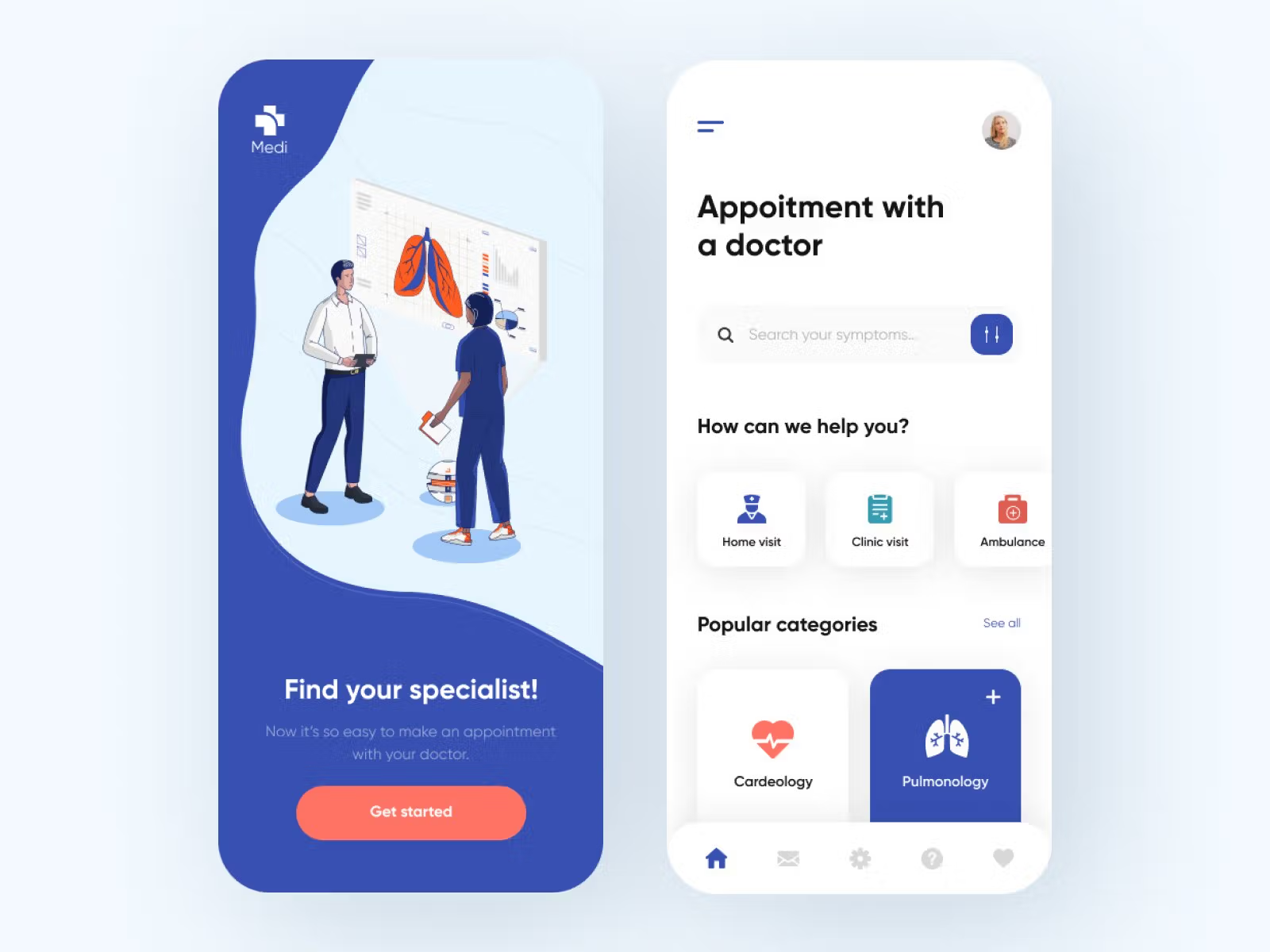
Telemedicine app (image by Anastasia)
Telemedicine is the solution to the problem. 89% of patients are willing to use telemedicine and accept it as a sufficient form of medical care. It shows us that telemedicine is not only needed but has a high demand.
The importance and benefits of telemedicine app development became especially clear during the COVID-pandemic. Many people would prefer to get medical care from their own homes and don’t unnecessarily risk their health. The same thing is true for healthcare professionals — they provide medical care remotely which mitigates the risk of getting a virus. Thus, telemedicine software makes it safer and more comfortable for both patients and doctors.
So now it’s easier than ever to develop a telemedicine platform and take off right from the start.
If you are interested in how to build a telemedicine app or website for doctors and patients but don’t know where to begin — we got you. Follow us to the next section!
✅ Top 4 Reasons Why You Should Develop a Telemedicine App
Before we get into details of telemedicine app development, why don’t we take a quick look at the benefits the telemedicine platform can bring you.
But firstly, we would recommend watching this video to better understand how important telemedicine apps are during COVID-pandemic:
Let's see what benefits can telemedicine software development bring you!
Reach a wider audience safely 👫
We all are used to taking it as a fact that to see a doctor we have to schedule an appointment in governmental or private healthcare organizations. Normally, we go somewhere near our home or in our city at least.
Speaking of telemedicine services, geolocation doesn’t play a significant role anymore. You can reach a wider audience and provide medical services from your web or mobile app to those who couldn’t get it without the platform because of being far from the hospital.
More importantly, if a person is infected by a virus and contagious, they won’t have to go to a hospital. Thus, the risk of getting other people or a doctor infected gets negated.
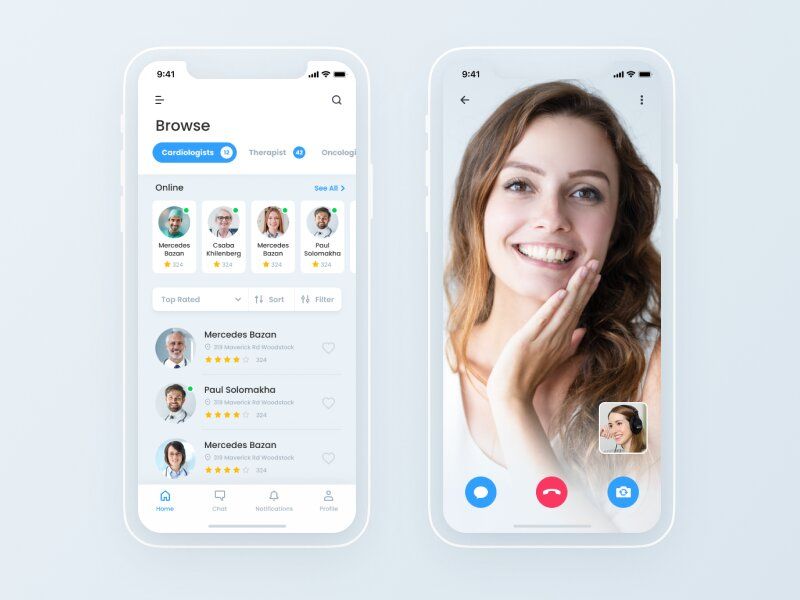
To provide remote medical healthcare services you need to develop a telemedicine app (image by Yarik Zinkof)
Especially now, when the world faced the COVID-19 pandemic, such remote medical care is popular as never before; and so is telemedicine app development.
With a telemedicine platform, or even a specialized yoga application development or corporate health app development, people can access healthcare or wellness services quickly and easily, with almost no hassle. Besides, they have an opportunity to choose a better or more suitable doctor for them since the list of healthcare providers is huge.
Moreover, there is a strong social aspect here. People who live in countryside areas happen to be more exposed to a poor healthcare system influence — they either can’t get to the hospital in a short time or can’t afford it.
Thus, telemedicine apps allow them to get appropriate medical care without spending money on the road to the hospital and to get it in case of an emergency. Technologies like video conferencing, artificial intelligence, and machine learning not only help to do this from home but also provide a stunning user experience.
Improve time-efficiency 🕘
We all know how time-consuming doctor visits can be. First, a patient needs to make it to the hospital, then spend quite a lot of time in the line. And what if he needs to see different specialists on the same day? It can take ages.
A significant advantage of telemedicine solutions, including those used to develop a mental health app, is the remote operation: no waiting, pre-appointment questionnaires, and quick transitions to video calls with doctors.
Doctors benefit from providing their services via an app as well. They constantly work under the huge pressure of working hours overloads. By building a telemedicine application for healthcare, you allow doctors to have better control over their working hours and improve their efficiency.
Thus, doctors can examine more patients in a shorter time, and with less hassle. Moreover, it's much easier to do patient monitoring, access health records, and so on. Thus, telehealth solutions will improve doctors’ mental health and sustainability. And we all know the rule: the healthier the doctor is, the healthier the patients are.
Keep medical record easier 📥
This part of running a business is often underestimated by owners. But in healthcare, it’s of high importance to safely store all patients’ history and their diagnoses, medical prescriptions, and other health information.
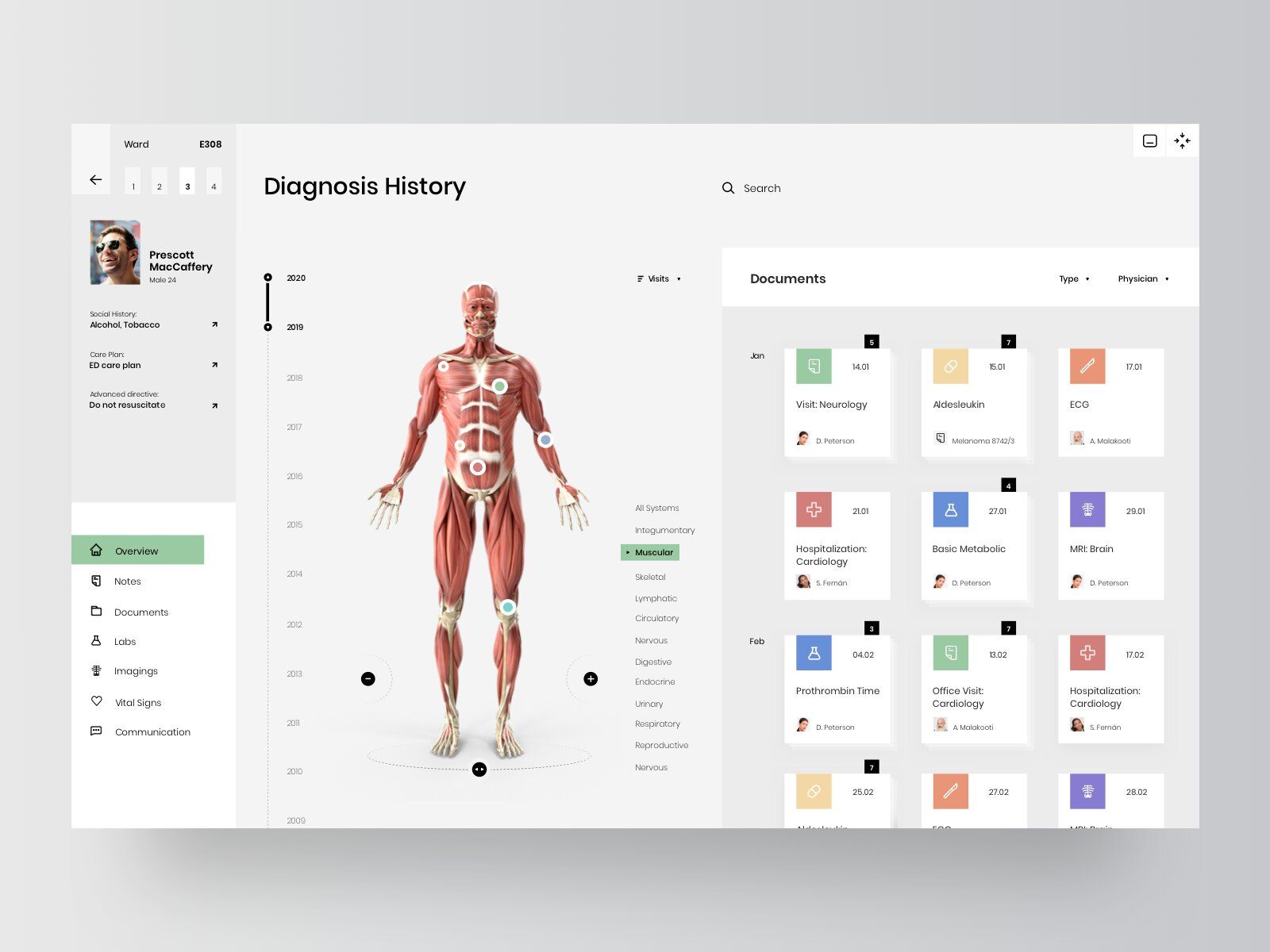
Diagnosis history is an important part of telehealth apps (image by RD UX/UI)
Telemedicine apps are just the ticket for this purpose. It’s not only easy to collect health data but to transfer it to other doctors as long as it doesn’t break the Patient Privacy Policy.
By collecting medical data, you contribute to research, help develop new treatments, and know more about different diagnoses. Consequently, you improve doctors’ knowledge and skills — the payment increases and the credibility becomes better.
Most importantly, you improve the quality of telehealth services you provide via the platform since it’s easier to access and store data.
Cut costs ❎
This is a clear advantage — online platforms, whether in telemedicine or meditation app development, tend to be cost-effective in the long run.
Of course, it doesn’t replace an offline hospital — many issues can’t be treated online. However, it significantly reduces costs and allows healthcare organizations to provide some primary care via a web or mobile app.
What is more, there will be less paperwork — almost everything can be digitalized and done in a telehealth app. It will not only cut costs by reducing paper use for documentation, doctor-patient agreements, and prescriptions but allow you to focus on actual tasks and profit increase as well.
⚙️ Top Features of a Telemedicine Platform
In this section, we will explore the basic and special features of telemedicine platforms, a crucial aspect of medical app development. It will help you to get a better vision of what app features you may need for telemedicine app development.
You should take into account that telemedicine apps can be web- or mobile-based. All features listed can be adapted for both types of platforms so we decided not to separate them.
Though, we divided features into two different types: common, and features for doctors and patients separately.
Here are the features to make your telemedicine software viable and stay ahead of the competition.
# 1: Sign Up & Profiles 🔐
Type: Common Feature
This feature is something that almost every web or mobile app has. However, to build a telemedicine platform for doctors you need to consider a few details.
First, you need to divide your Sign Up into two categories: for doctors and patients.
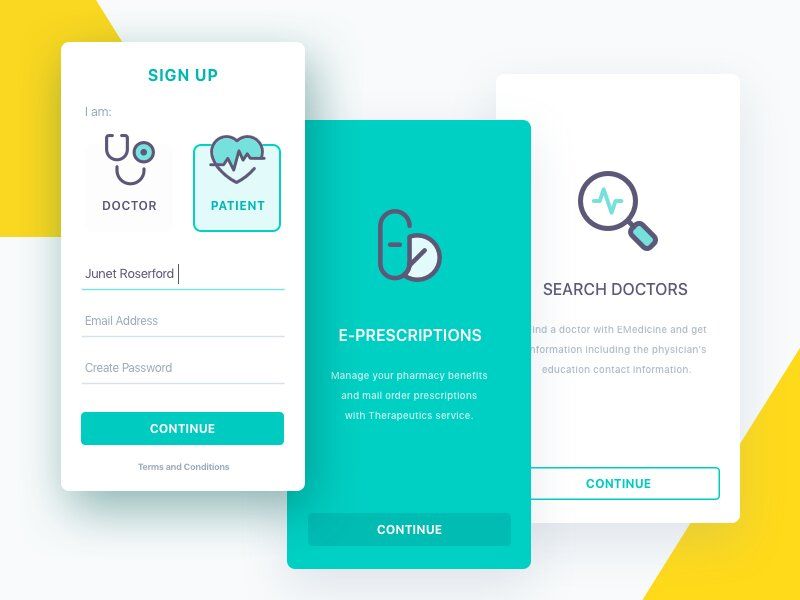
When developing a telemedicine app, pay attention that you follow all the HIPAA compliance guidelines (image by Andrew Horuzhii)
You can ask for details after they sign-up or for basic ones (email or phone number, name, and specializations) right at the start — either way they will have to provide them since telemedicine is quite a responsible business to run. For different categories, you would need different details. Except for basic info like name and email/phone number, you’ll also need to collect more detailed info:
👩⚕️ For doctors | 🤒 For Patients |
|---|---|
ID card | Sex, age |
Diplomas & certificates | Body dimensions (weight, height) — it’s important for prescriptions |
Work experience | Any special details about their health — allergies, lactose intolerance, diabetes, etc |
Insurance (if they have one) |
# 2: Home Screen 📊
Type: Common Feature
Home Screen is the first thing users see in a telehealth apps. So it has to be useful and convenient but not overloaded.
Home Screen for patients and doctors should be different.
For Doctors
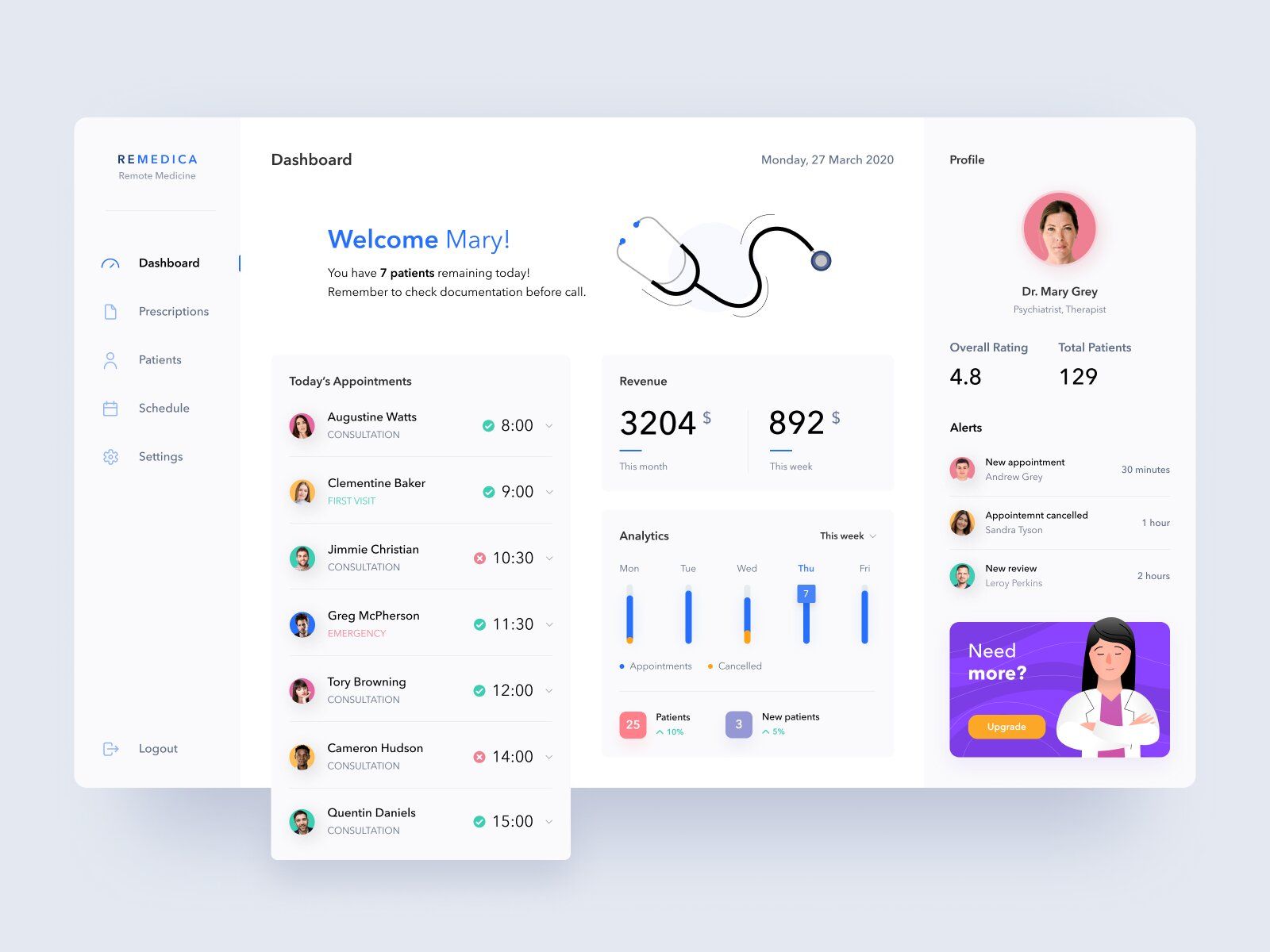
During your telemedicine app development make sure that healthcare providers have as good user experience as any patient (image by Arek Borysiuk)
Home Screen for doctors may display:
- Revenue.
Consider adding this feature to help doctors track their income. It can be a monthly or weekly income, or an income for different months.
- Today’s appointment.
This one can help doctors with managing their time and make sure that every single patient on the list gets appropriate treatment.
- Rating.
This feature of telemedicine applications is quite a useful indicator that will allow doctors to understand whether patients are satisfied with the healthcare services they provide or not and give better medical care in the future.
- New patients.
The list of new patients is intended to let doctors know how many people are willing to see them in the nearest future and control their workload right at the stage of reviewing patients’ requests.
- Quick access to the client’s history and health records — complaints, questionnaires, etc.
To provide better services doctors should be able to see the client’s history — it’s like an outpatient e-chart — quickly from their dashboard.
For Patients
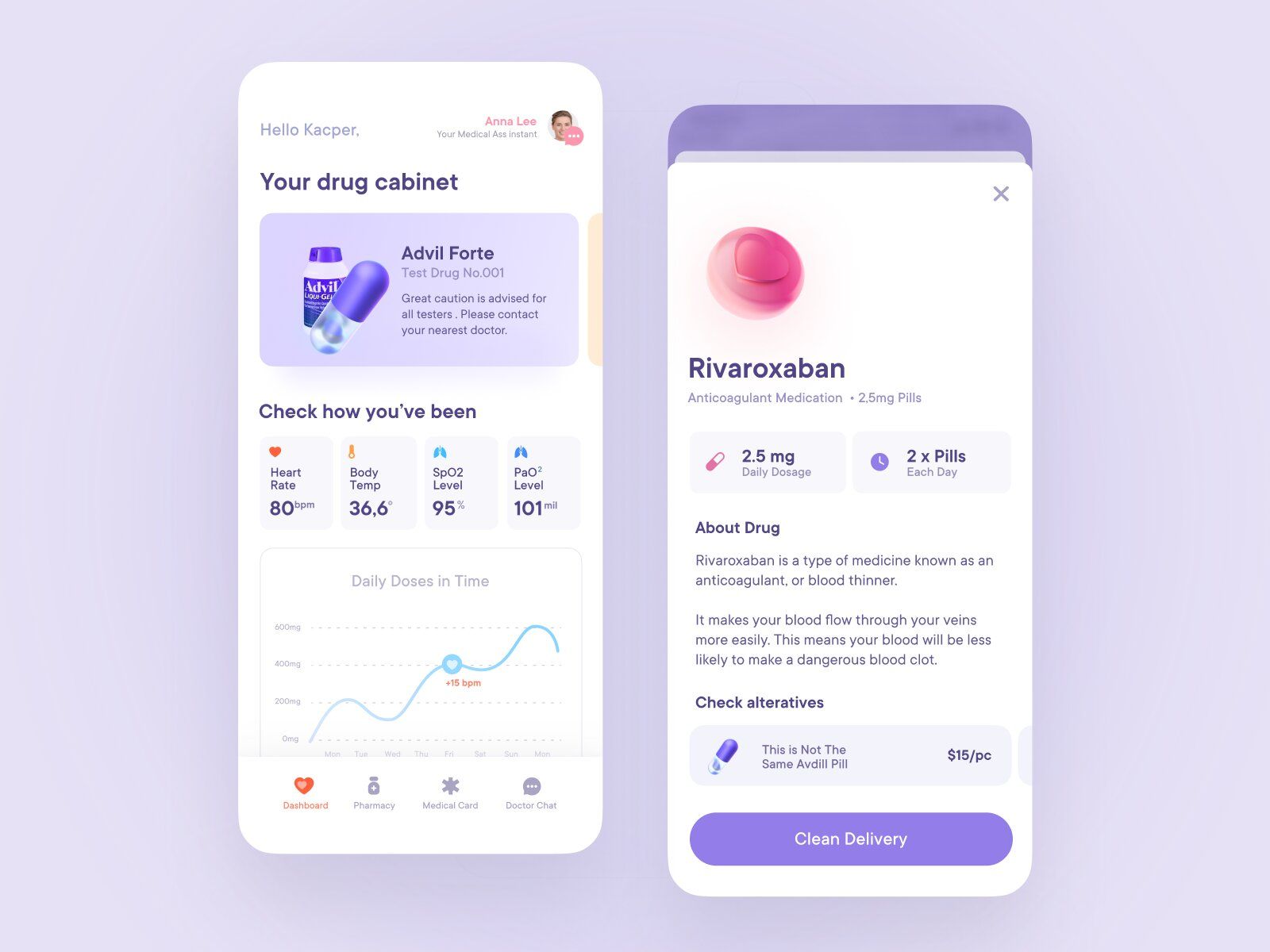
The benefits of telehealth app development for patients go much further than just video calls (image by Michal Sambora)
The same screen but for patients should consist of:
- Search bar.
To make the search quicker it’s a good idea to add a search bar to the Home Screen for patients so that they can easily find a doctor they need without going too far on the list.
- Appointments calendar.
The calendar can work as a reminder for appointments. We would recommend highlighting the dates with any bright color to make sure that they’re flashy.
- Quick access to main features — list top of doctors, prescriptions, and recommendations, chat or video conferencing with a doctor.
Such a feature is needed to be able to get the most important information right after users open the app so that they don’t miss any medication or messages from their attending physician.
- Health & Movement indicators
It’s an additional feature that you could use to stand out. Provide patients with activity trackers and give them superficial information (heartbeat, steps per period of time, etc.) about their current state of health. This feature is quite useful if you want to create a telemedicine app for daily use.
ALso, we offer services to create a personal trainer app that meets high-quality standards.
# 3: List of Doctors & Filters 🔍
Type: Features for Patients
Patients should be able to see a list of all doctors with their name, specialization, average rating, and the price for the visit. To make the search faster you can add categories of doctors’ specialization like in this picture.
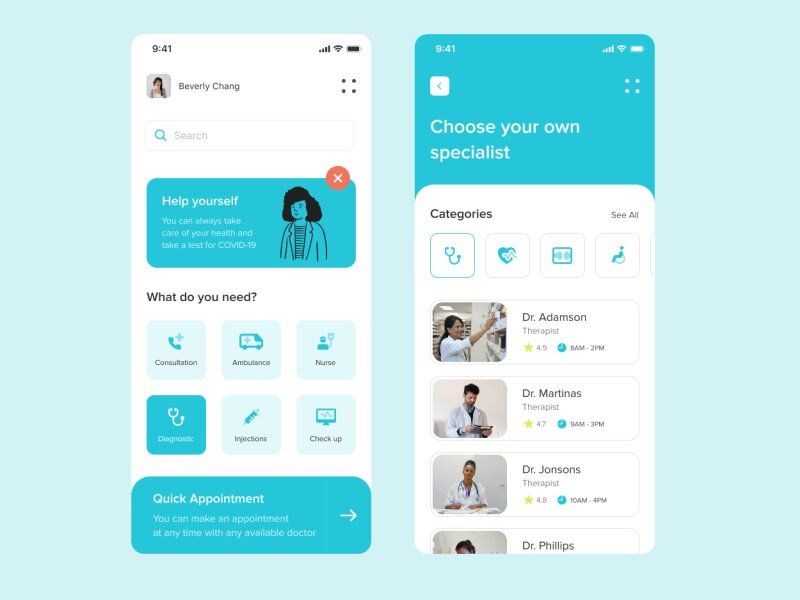
A list of healthcare providers is a necessary part of any telemedicine app (image by Rhinoda Team)
When pressing on the “Book an appointment” button (which should be added near each doctor’s name as well), they need to be provided with all necessary details and their potential doctor: other patients’ comments, doctors’ education, experience, free dates along with the time.
It’s a good idea to add search filters into your telehealth software. This way you'll make search results as precise as possible. For example, you may add some of these filters:
- by specialization;
- by price;
- by available dates;
- by location.
# 4: Questionnaires & Health control 📋
Type: Common Feature
Before the appointment nurses usually ask patients to fill in some medical forms with questions about the patient's background, basic health indicators, and complaints.
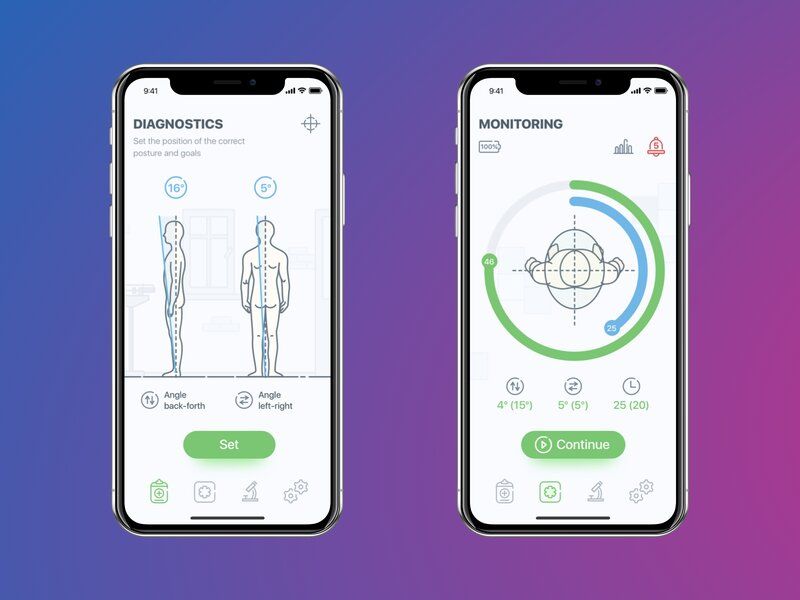
Telemedicine applications often include in-app questionnaires for patients (image by Dinis Bazgutdinоv)
With telemedicine apps, it gets much easier for both patients and doctors. A patient can open the premade file and fill it in from a device. The doctor can access the file remotely and look it through in a telehealth app before the appointment.
Besides, it really helps to track the progress and effectiveness of treatment, change it in case a patient's well-being gets worse, and keep medical records for research.
# 5: Video & Audio Calls 📞
Type: Common Feature
This feature is essential for building a telemedicine video mobile app. It creates a live communication feeling and helps to make the doctor-patient relationship more trusting.
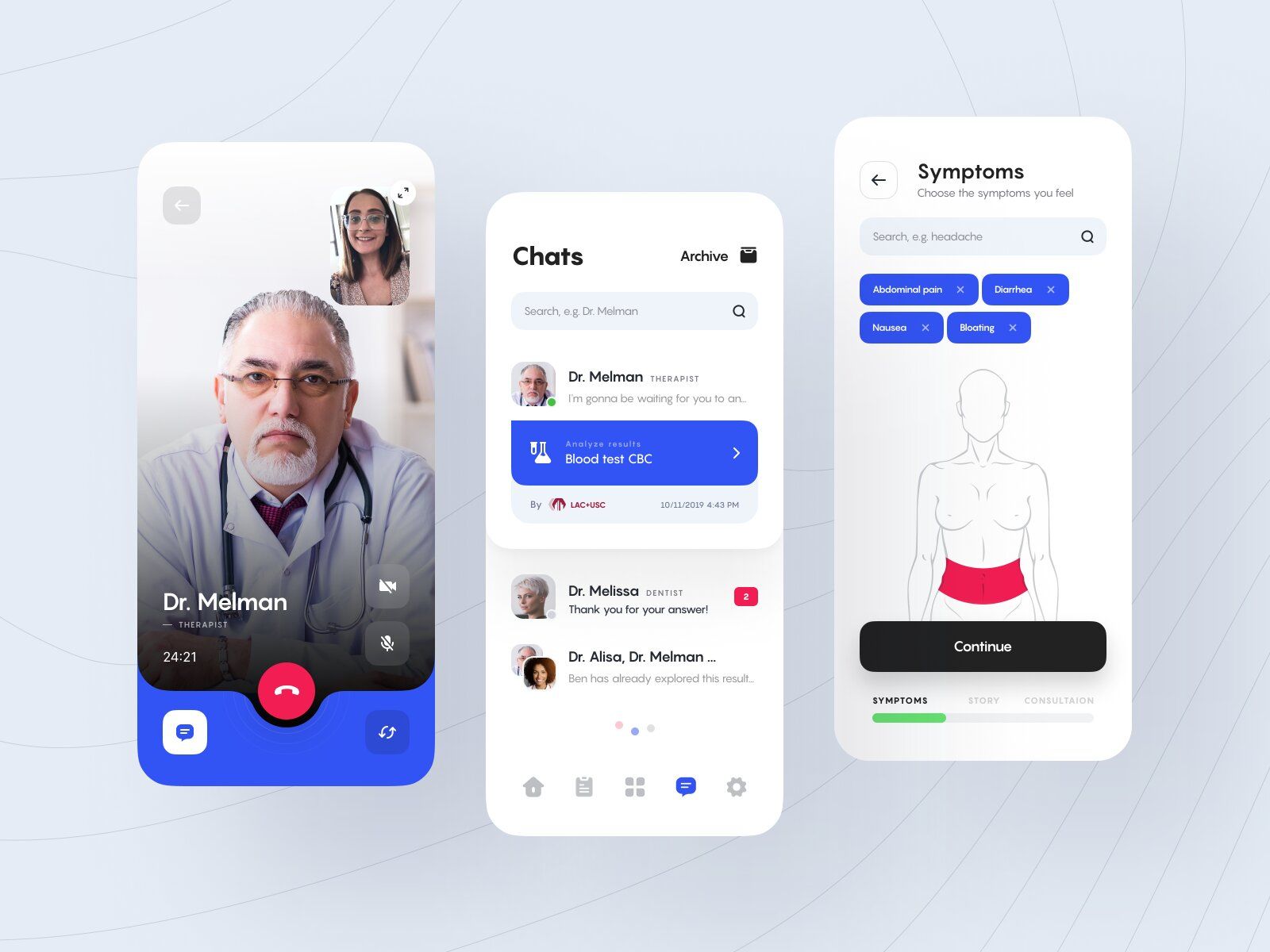
Video conferencing is an important part of any telemedicine software development (image by Alexander Plyuto 🎲)
Moreover, it helps a doctor to see a patient's external symptoms and their well-being (whether they’re sleepy, pale, dizzy, etc.). Moreover, it's possible to use some machine learning and artificial intelligence algorithms to make more accurate diagnoses.
If it is a therapist appointment, then emotions, reactions of a patient, and faces of both doctor and patient play one the most crucial roles.
# 6: Feedback 💬
Type: Features for Patients
The reputation of any doctor is critical — knowing about other people’s experiences can prevent a lot of troubles or ensure to choose this or that doctor.
In online telehealth apps, it’s easier than anywhere else. Just leave a comment on a doctor's profile or rate them.
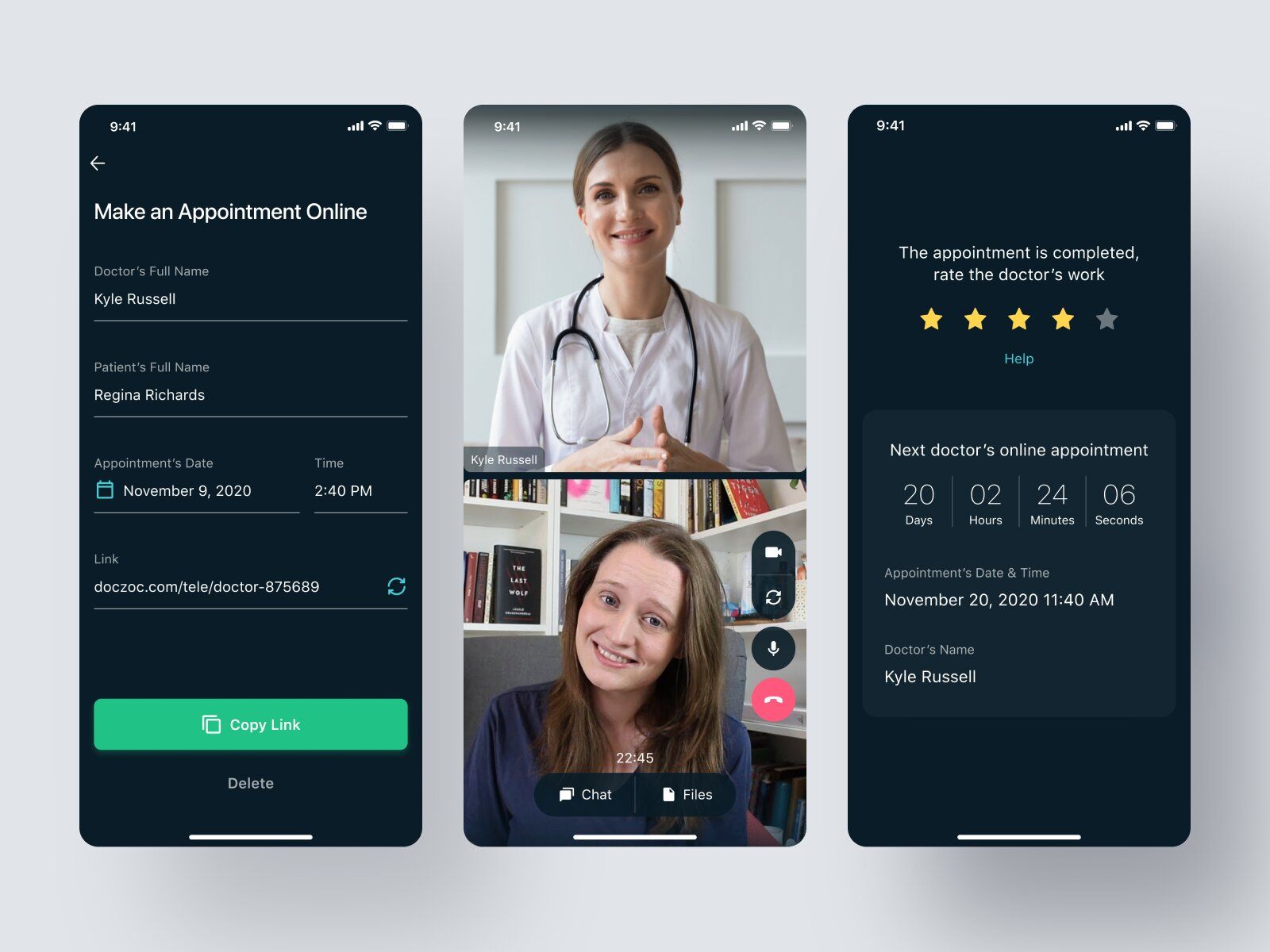
Feedback form in a telemedicine mobile app after an appointment (image by Yury Komarovsky)
It would be great if you implement some premade feedback forms with the most important questions (“Did the doctor ask you about…?”, “Rate the efficiency of a treatment”, etc.).
# 7: File Uploading & Downloading 📤
Type: Common Feature
A doctor may need their patients to upload a picture of their rash on a hand, for instance. Or to take a photo of their bruise. Or some patients may want to print out their X-Ray scans, prescriptions, diagnoses, and so on.
That is when the file uploading feature could come in handy. Consider this during your own telemedicine app development.
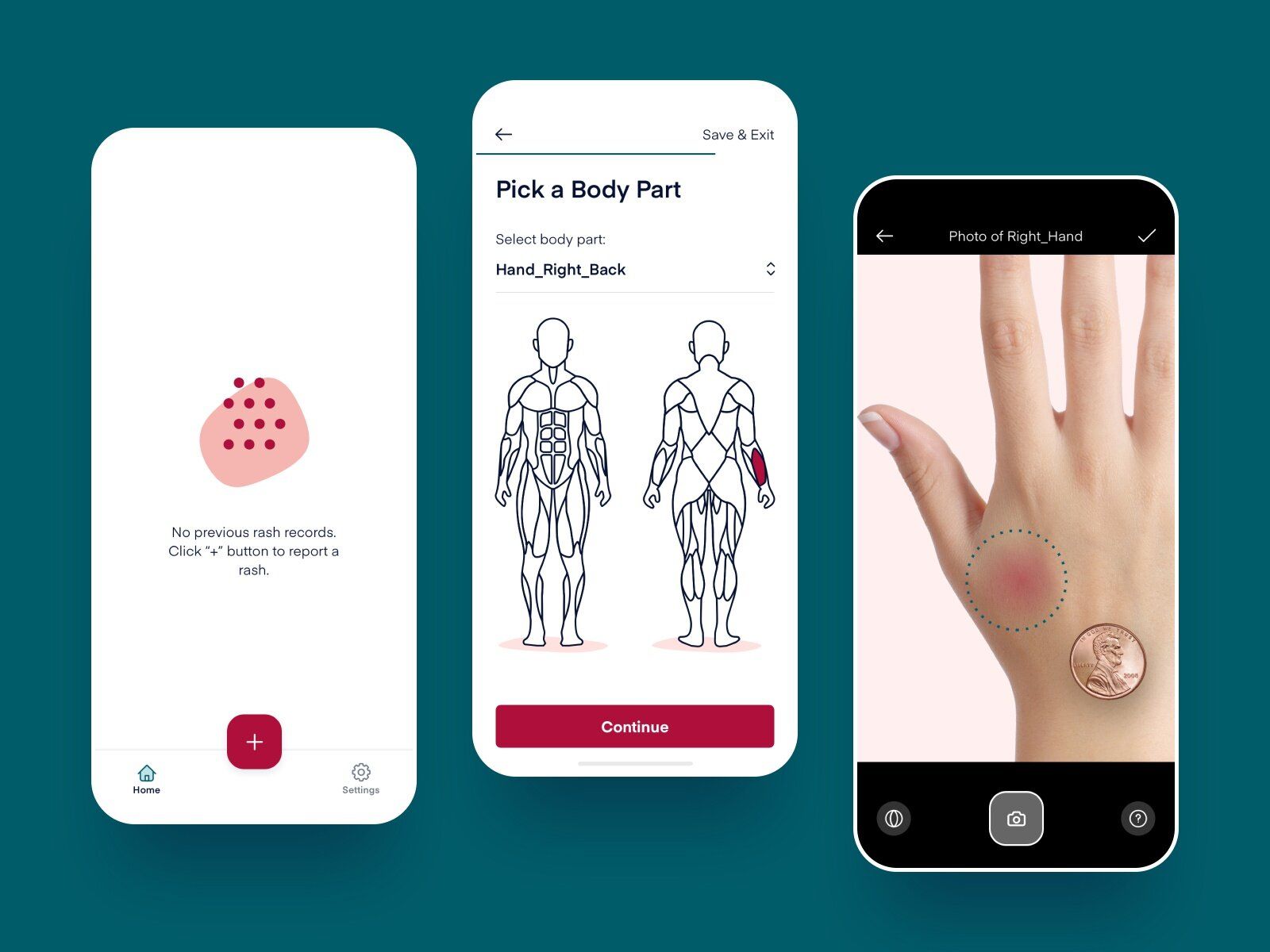
Camera in a telemedicine app (image by Filip Justić)
For this purpose, you can ask your users for camera permission so that they can use it right in your web or mobile app.
# 8: Medical History 📘
Type: Features for Patients
Patients should be able to access their current and previous diagnoses, prescriptions, and medical records.
The reason is pretty obvious — to be aware of what’s happening to the body and recall the information a doctor said during an appointment.

Medical history is one of the essential telemedicine app features (image by Ahmed Mokhtar)
Doctors should be able to access this information as well to provide better treatment taking into account previous occasions and details that popped up while seeing another doctor.
# 9: Schedule 📅
Type: Features for Doctors
Such an essential feature is intended to allow doctors to take control of their workload easily — see how many patients are on today’s agenda, how many new patients are willing to make an appointment.
Don't forget that telemedicine software development is not only about patients but also about healthcare providers.
# 10: Chats 💭
Type: Common Feature
In case of an emergency or some additional questions, patients should have an opportunity to reach out to their doctor. And chats in telemedicine apps work perfectly for such a need.
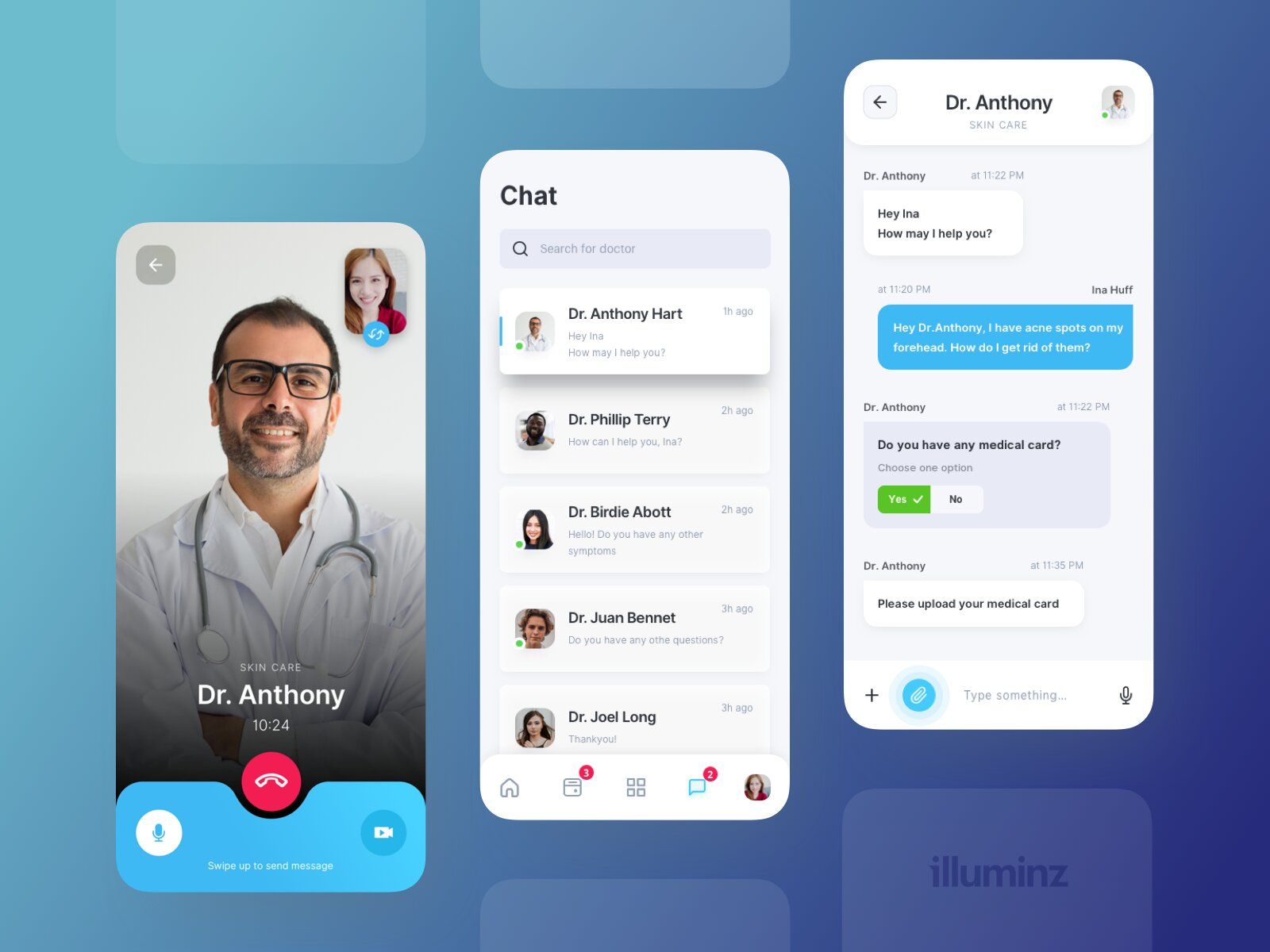
Chat in a telemedicine app (image by Arjun Singh)
It can also be useful for explaining any tests or scans a patient did so that everything is as clear as possible.
Consider adding “Smart Response” as an additional function to make the use of your app time-efficient for both doctor and patient.
# 11: Customer Support 🤝
Type: Common Feature
In case something from a technical side goes wrong, customer support should be there to help.
We would recommend implementing AI (chatbots) during your telemedicine app development (explore how to integrate AI in app development)They are programmed to answer the most common questions or to offer an email/messenger connection to ask an additional question that's not on the list. Thus, telemedicine apps can save a lot of time that's now wasted on basic conversations.
Customer support service should:
- Be quick.
- Offer 24/7 phone support in case of an emergency.
- Provide a list of contacts (email, messengers, etc.).
# 12: Payment Gateway 💲
Type: Common Feature
To make the doctor-patient partnership easy and secure use a great Payment Gateway for all in-app transactions. By great we mean:
- It’s consistent with device and OS types.
- Most popular payment options are available (Google Pay, Apple Pay, PayPal).
- Works fast and without delays.
- Secure.
Don't underestimate this part of the telemedicine app development process. Just like medical records, it requires even more attention and security than other telehealth app features.
# 13: Push-Notifications 🔔
Type: Common Feature
Push-notifications can be useful for everybody: business owners, doctors, and patients.
Business owners can increase revenue by sending personalized offers.
Doctors can get new messages from patients, notifications, reminders about appointments (this one should be able to be customized. “Remind N min before the appointment”, etc.).
Patients can get reminders for appointments as well. Besides, it’s not excessive to offer reminders for taking pills, test results, and so on. Thus, users will use your telemedicine application more often.
🔐 How to Ensure Security in Your Telemedicine App
We know how important it is to trust your doctor — everybody feels the need for his information to be secure and stay private. Thus, it's often an important part of telehealth app development.
On a telemedicine platform, to make your users’ personal information and business data completely secure you should follow the following steps.
Security Measures You Can Implement during Telemedicine App Development 🔑
# 1: Data Encryption
Nowadays frauds and hackers can use stolen data for blackmailing, manipulations, reselling, and many other harmful things for both businesses and users. We bet you don't want it for your telemedicine mobile or web app.
One of the best things you can do to prevent data leakage is encryption for transmitting and storing.
When developing a telemedicine app, take into account that a big part of doctors’ appointments will be done via video calls it’s of high importance to pay attention to encryption at this stage.
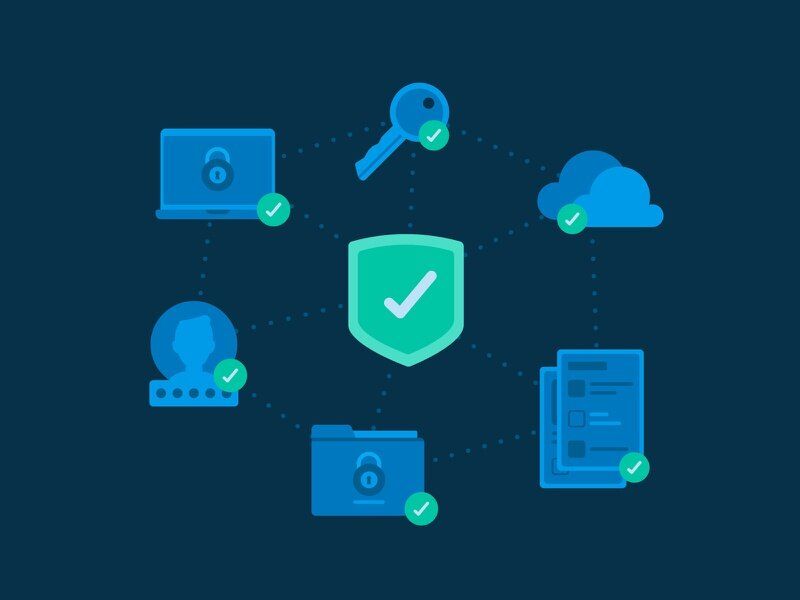
Pay attention to security features during the telemedicine app development process (image by Parham Marandi)
Thus, even if a third party gets access to your app’s information they wouldn’t be able to decrypt it.
End-to-end encryption (E2EE) is what many businesses use to encrypt the in-app communication and transactions from hackers, the government, and even from the facilitating company as well.
So if you’re considering implementing encryption to your telemedicine software we would recommend paying attention to the E2EE.
# 2: Proper Data Storing
The way you store medical data plays a significant role. It’s easier to exploit data from a server that is overloaded. Here are two main tips you can follow to store it securely and minimize the risks:
- Don’t keep unnecessary information.
It can be tests or scan results that aren’t relevant anymore, information about patients that’s no longer used, any duplicates of documents, and so on.
This approach will reduce the server load and make managing & maintaining telemedicine apps easier.
- Keep data restricted & protected.
This one may seem obvious — not everybody has access to the information. However, it’s essential to limit the number of employees who have it to certain data.
That means the access shouldn’t be unlimited — it’s not necessary for an accountant to be able to enter the files with prescriptions. Thus, as you develop a telemedicine app, define different categories of users that have different levels of access.
Besides, all server storages have to be under the protection of secure firewalls, systems of passwords, and authentications. Yet, this is a task for your telemedicine app developers.
# 3: Educating Your Doctors
It's not enough just to develop a telehealth web or mobile app. The doctor-patient relationship is one of the most crucial parts of the successful treatment of a disease. Thus, they have to be aware of all details of treating patients online, be responsible for patient’s privacy and data protection.
Moreover, each web or mobile app is unique and has special features or the way they function. Doctors should be informed of how each of them works and how to behave in order to protect a patient’s data.
But not only patients and businesses are interested in the data being private. At the end of the day, patients are doctors’ reputation and their responsibility — if something goes wrong the doctor is the one who the patient will talk to at first.
All mentioned above proves to us that privacy & security is something that everybody using or working with an app is interested in. Basically, security has to be on top — it’s the key to success in telemedicine and wellness application development.
Regulations 📚
Sure thing that medical apps are nothing different from medical offline institutions when talking about compliance with various medical and data security regulations. Even more: telehealth app development has its own very special requirements.
In other words, you have to pay attention to some patient data privacy regulations and learn what it means to be GDPR, PIPEDA, or HIPAA compliant:
- GDPR (General Data Protection Regulation) is a privacy and security law of the European Union relevant to any institution or business that works with information related to the EU citizens.
- HIPAA (Health Insurance Portability and Accountability Act) is a regulation for US businesses that requires healthcare institutions and businesses, and their associates to develop and follow methods that ensure the security and confidentiality of patients’ data when it is received, transferred, shared, or handled. Thus, this regulation directly affects telemedicine solutions.
- PIPEDA (Personal Information Protection And Electronic Documents Act) is a Canadian federal privacy law intended to govern the use and collection of personal information in a way that complies with the right of privacy of individuals.
🚀 Tech Stack for Telemedicine Software Development
To make your app more convenient to use you could implement different APIs and SDKs for telemedicine app. Here is the list:
- Symptom Checker API is indented to provide help in identifying what diseases a patient might have. Based on this info, your app with the implemented API will determine the most appropriate doctors for further consultations.
- SimplyBook.me API implements an automated appointment scheduler.
- BetterDoctor API can be used to add doctor data into the healthcare project.
- To provide your users with a fully flexible communication cloud platform consider implementing Vonage API.
- For managing payments, we would recommend implementing Stripe and Braintree SDKs since they’re secure and fast. The necessary technology for telemedicine app development.
💰 How Much Does It Cost to Develop a Telemedicine Platform?
In this section, we’ll provide you with a rough estimate of telemedicine app development costs.
By rough we mean that they may differ depending on your platform’s structure, various technologies, and integrations.
Our estimations use an average rate for Eastern Europe of $45/hour, however, your development team can take more or less which surely changes the estimate.
🏥 Telemedicine App Development Estimated in Hours
Using React Native
⚙️ Features | ⏳ Min Hours | ⏱ Max Hours |
|---|---|---|
🛠 Common | 124 | 177 |
UX/UI design | 40 | 64 |
Splash | 6 | 8 |
Animations | 10 | 14 |
Technical foundations | 10 | 15 |
Navigation | 10 | 12 |
Deployment | 8 | 12 |
QA | 32 | 40 |
App Stores Submission | 8 | 12 |
🔐 Sign Up Flow | 25 | 40 |
Onboarding | 10 | 15 |
Sign Up Screen | 10 | 15 |
Forgot Password | 5 | 10 |
👤 Profile Management Flow | 22 | 30 |
Upload a photo | 10 | 14 |
Personal details | 12 | 16 |
👩⚕️ Home Screen (doctors) | 45 | 59 |
Revenue Dashboard | 20 | 25 |
Upcoming appointments | 15 | 20 |
Rating & Reviews | 10 | 14 |
🤒 Home Screen (patients) | 34 | 49 |
Search bar | 6 | 8 |
Upcoming appointments | 10 | 14 |
List of doctors | 8 | 12 |
Prescriptions | 10 | 15 |
📋 List of Doctors & Filters | 22 | 30 |
Filters (by specialization, price, availability, location) | 10 | 14 |
Book an appointment | 12 | 16 |
📝 Questionnaires & Health control | 24 | 34 |
Questionnaires | 6 | 10 |
Well-being check-ups | 18 | 24 |
📹 Video calls | 60 | 120 |
👍 Feedback | 18 | 26 |
Rating | 6 | 10 |
Leave a comment | 12 | 16 |
📤 File Uploading | 12 | 16 |
💬 Chats | 45 | 60 |
🤝 Customer Support | 48 | 72 |
Chatbot | 40 | 60 |
Q&A Screen | 8 | 12 |
💳 Payment Gateway | 40 | 60 |
🔔 Push-notifications | 16 | 32 |
⏱ Total Hours | 535 | 805 |
💵 Approximate costs | $24,075 | $36,225 |
Thus, the rough cost to develop a telemedicine app is between $24,000-$36,000. Don’t forget, it’s a rough estimate.
The number of features, needed technologies & integrations, as well as an hourly rate of your development team for telemedicine app development services, will likely change your expenditures and fitness app development cost.
💡 Takeaways
Now you fully understand what main steps you should take to develop a web-based telemedicine system or mobile telehealth application and how you can benefit from it.
It’s hard not to see how life-saving telemedicine web and mobile apps are. Thus, telemedicine app development is not only socially important but also quite beneficial from the business perspective.
To sum up, to develop a telemedicine platform you should:
- Decide on whether it should be web- or mobile-based.
- Choose the features you want to see on your platform.
- Check all security regulations your platform has to comply with.
- Find a Tech Partner and start your development journey.
Have any questions on telemedicine app development? Don’t hesitate to drop us a line! Or you can tell us about your idea and we’ll see how we can help!
Was it helpful?
Read also

10 Innovative Fitness Application Ideas: Revolutionizing Personal Health and Wellness

How to Add AI to Your App: Guide With Examples

How to Develop a Wellness App: Case Study-Based Guide
Our clients say
![Stormotion client Alexander Wolff, CPO from [object Object]](/static/a16ba3c9580effc3ab9a68d115eadffe/b0e74/alex.png)
When I was working with Stormotion, I forgot they were an external agency. They put such effort into my product it might as well have been their own. I’ve never worked with such a client-focused company before.
Alexander Wolff, CPO
Sjut
